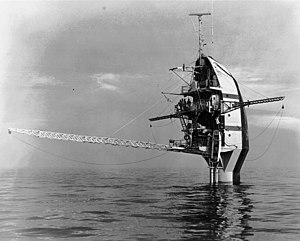RP FLIP

| |
| History | |
|---|---|
| Owner | Office of Naval Research |
| Operator | Scripps Institution of Oceanography |
| Builder | |
| Cost | Approximately US$600,000[1] |
| Launched | 22 June 1962[1] |
| Completed | 23 July 1962[1] |
| In service | September 1962[1] |
| Identification |
|
| Status | Operational |
| General characteristics | |
| Type | Research platform |
| Tonnage | 700 GT[2] |
| Length | 108 m (355 ft)[2] |
| Beam | 7.93 m (26.0 ft)[2] |
| Draught | |
| Installed power | |
| Propulsion | None |
| Speed | Towed: 7–10 kn (8–12 mph; 13–19 km/h)[2] |
| Endurance | 35 days[2] |
| Capacity |
|
| Complement | 5 crew, 11 researchers[2] |
R/P FLIP (FLoating Instrument Platform) is an open ocean research platform[4][5] owned by the U.S. Office of Naval Research (ONR) and operated by Scripps Institution of Oceanography.[6] The platform is 108 meters (355 ft) long and is designed to partially flood and pitch backward 90°, resulting in only the front 17 meters (55 ft) of the platform pointing up out of the water, with bulkheads becoming decks. When flipped, most of the buoyancy for the platform is provided by water at depths below the influence of surface waves, hence FLIP is stable and mostly immune to wave action similar to a spar buoy. At the end of a mission, compressed air is pumped into the ballast tanks in the flooded section and the platform, which has no propulsion, returns to its horizontal position so it can be towed to a new location.[7] The platform is frequently mistaken for a capsized ocean transport ship.[8]
History


The Marine Physical Laboratory of Scripps Institution of Oceanography created FLIP with funding from the Office of Naval Research and the assistance of the commercial naval architecture firm The Glosten Associates.[1] FLIP was originally built to support research into the fine-scale phase and amplitude fluctuations in undersea sound waves caused by thermal gradients and sloping ocean bottoms. This acoustic research was conducted as a portion of the Navy's SUBROC program. Development started in January 1960 after a conversation between MPL researcher Frederick H. Fisher and MPL Director Fred N. Spiess regarding stability problems that Fisher was encountering when using the submarine USS Baya (SS-318) as a research platform. Spiess recalled a suggestion from Allyn Vine that upending a ship might make it more stable, based on Vine's observation of a Navy mop floating in waves. Fisher was subsequently assigned to work on the feasibility and later development of such a vessel. The Gunderson Brothers Engineering Company in Portland, Oregon, launched FLIP on 22 June 1962. In 1995, FLIP received a US$2 million modernization.[9]
Capabilities
FLIP is designed to study wave height, acoustic signals, water temperature and density, and for the collection of meteorological data. Because of the potential interference with the acoustic instruments, FLIP has no engines or other means of propulsion. It must be towed to open water, where it drifts freely or is anchored. In tow, FLIP can reach speeds of 7–10 knots.[9]
FLIP is 700 gross tons. It carries a crew of five, plus up to eleven scientists. It is capable of operating independently during month-long missions without resupply.[10] It can be operated around the world, although the normal area is off the west coast of the United States. The ship has specially designed interiors. Some fixtures, such as the toilet seats, can flip 90°. The lights are on the ceiling and also on a wall that becomes the ceiling after the flip. Also, the shower heads are curved 90°. The vessel operates out of a home base at Scripps' Nimitz Marine Facility in San Diego, California.[10]
References
- ^ a b c d e "FLIP: History". Scripps Institution of Oceanography, Marine Physical Laboratory. Retrieved 13 August 2012.
- ^ a b c d e f g h "Research Vessels". United States Navy, Office of Naval Research. Archived from the original on 14 April 2009.
- ^ a b Bronson, Earl D.; Glosten, Larry R. (October 1985). FLIP: FLoating Instrument Platform. Scripps Institution of Oceanography, Marine Physical Laboratory.
- ^ a b c "FLIP: Description". Scripps Institution of Oceanography, Marine Physical Laboratory. Retrieved 12 April 2014.
- ^ Jean, Grace (22 June 2012). "Navy's Floating Research Platform 'Flips' for its 50th Anniversary". United States Navy, Office of Naval Research. Retrieved 11 April 2014.
- ^ "Research Vessels: Surface Vessels - R/V FLIP". United States Navy, Office of Naval Research. Retrieved 21 August 2010.
- ^ "All About F.L.I.P." Woods Hole Oceanographic Institution. Retrieved 21 August 2010.
- ^ Fisher, Fred (2002). FLIP - The World's Strangest Research Lab. YouTube.com. Scripps Institution of Oceanography. Retrieved 21 August 2010.
- ^ a b Explorations (PDF). Vol. 2. Scripps Institution of Oceanography. 1996. p. 63. Annual Report Fiscal 1995.
- ^ a b "FLIP ship gets a lift from USNS Navajo". United States Navy, Military Sealift Command. October 2003. Retrieved 21 August 2010.
External links
- R/P FLIP homepage
- "FLIP - Research Vessel" on Ship-Technology.com
- "The Boat Designed to Capsize" on Damn Interesting
- Media
